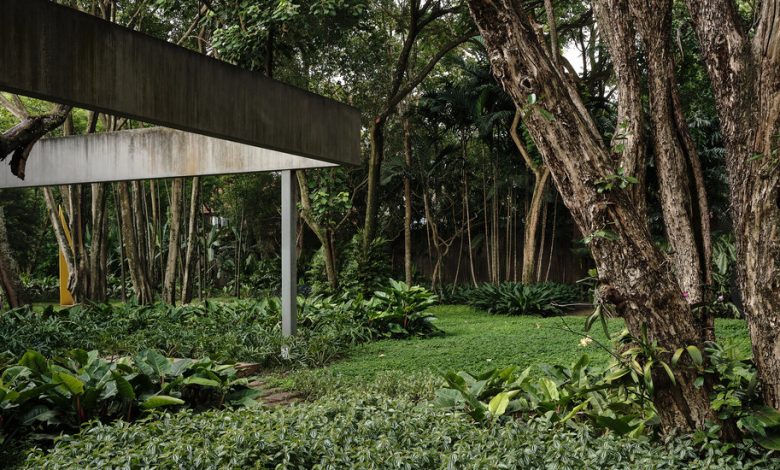How Do You Build a Jungle?

THE ARCHITECTS MARCIO Kogan and Renata Furlanetto of the Brazilian firm Studio MK27 had just broken ground on a new house in São Paulo in 2010 when the landscape designer Isabel Duprat informed them that they’d have to raise the entire 10,225-square-foot project, known as Casa Rampa, by almost 20 inches. The root system of a towering sibipiruna tree — a flowering giant native to the Atlantic rainforest ecosystem that once encompassed much of Brazil’s coast — extended farther into the plot than they’d thought. Maintaining the original position of the residence, a second home for a couple and their art collection, would mean fatally destabilizing the plant. “There were two options: You move the house, or the tree dies,” says Duprat, 69, on a temperate afternoon this past August, standing beneath its delicate bipinnate leaves. The architects didn’t hesitate: “We never touch big trees,” says Kogan, 72.
Today, that plant is one of thousands on the grounds, a place where monarch ferns frill around the auburn necks of melinonii philodendrons and buttercream and magenta orchids hang like pendants from a jabuticabeira, its spreading copper limbs blistered with purple fruit. It takes precision to harness so much abundance; raising the house to save the sibipiruna, for instance, meant inserting tiers in the terrain to avoid girdling the roots of pre-existing loquats and phoenix palms. To place ipê and capirona trees, both Amazonian hardwoods, Duprat stood on the house’s second-floor balcony and directed her team of five gardeners below as they rotated each plant, composing the canopy to eliminate views of nearby high-rises. The rescued tree, says the 48-year-old Furlanetto, “became part of the architecture,” casting shadows through a skylight that dapple the internal concrete ramp for which the project was named. The rest of the house, says Diana Radomysler, MK27’s 63-year-old director of interiors, “was a frame for the garden.”
The integration of nature and built space has defined Brazilian architecture since the 1930s, when the painter and self-taught landscape architect Roberto Burle Marx started doing gardens for some of the country’s most iconic Modernist buildings. For his earliest public projects in the northern city of Recife, where a Dutch administrator had planted Brazil’s first known gardens nearly 300 years earlier, Burle Marx scandalized Eurocentric elites with his use of Amazonian lily pads and cactuses from the arid Caatinga, an impoverished region in the country’s interior. “They claimed I was trying to return their city to the jungle,” Burle Marx would recall in 1994, just before his death at age 84, although he had no interest in rewilding. Rather, he wanted to cultivate a distinctly Brazilian idiom. Beginning with the Italianate geometries of Rio de Janeiro’s Passeio Público, the country’s first municipal garden, built over a pestilential lagoon between 1779 and ’83, Brazilian parks often mirrored European ones. The botanical gardens of the late 18th century replicated the era’s “green imperialism,” as the 67-year-old architect and professor Hugo Segawa puts it, “a way to dominate the world by dominating its knowledge of plants.”
By the end of the 19th century, French landscape architects like Auguste François Marie Glaziou and his protégé Paul Villon had transformed the gardens in Rio, then the nation’s capital, with winding paths and follies like those found throughout London and Paris. Like Glaziou before him, Burle Marx went on frequent exploratory missions into Brazil’s hinterlands to collect and identify native species; but where the French designer deployed the flora in patterns lifted from the Old World, Burle Marx molded them — along with acclimatized exotics — into sweeping, color-blocked abstractions, indivisible from (and no less manufactured than) the buildings they surrounded. By 1991, when New York’s Museum of Modern Art mounted a retrospective of his work, he had become the world’s most renowned living landscape architect.




